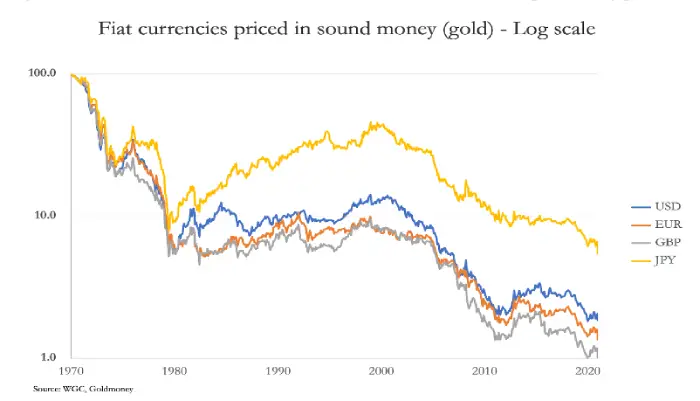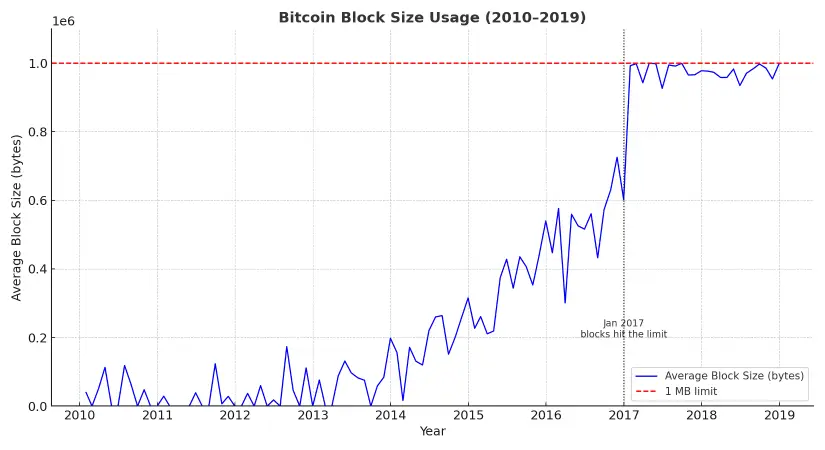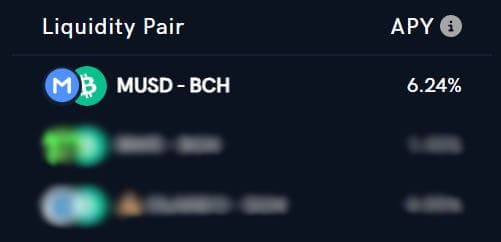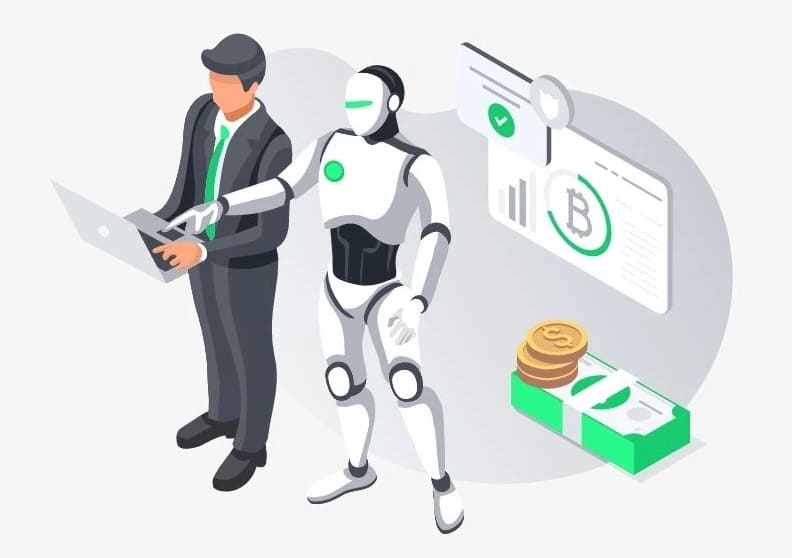Bitcoin evolved in 2017 to preserve decentralized sound money — under the name Bitcoin Cash.
Understand what happened to Bitcoin, why Bitcoin Cash exists and the differences between BTC and BCH.
We Know Why Bitcoin:
They Print — We Pay

Fiat currencies' value trends to zero vs gold

"I don't believe we shall ever have a good money again until we take the thing out of the hands of government.
We can’t take it violently out of their hands. All we can do is, by some sly roundabout way, introduce something that they can’t stop."
Friedrich Hayek — Nobel Prize economist (1974)
Bitcoin was created to solve this problem: scarce sound money no one can manipulate
When BTC turned into an investment asset, Bitcoin Cash restored Bitcoin’s purpose — hard money without middlemen for a free market and a prosperous future
Optionally jump to:
What happened to Bitcoin and why BCH exists
Bitcoin is the invention of the century: scarce peer-to-peer electronic cash meant to bring the separation between money and State.
For years, it worked exactly as intended. But as adoption grew, a key limit in the code was reached — and by 2017, the consequences could no longer be ignored.
“Bitcoin is two things which share a name. One, it's a payment system, and two, it's a currency. You use the Bitcoin payment system to send bitcoins as currency from one account holder to another. The transfer is instantaneous, carries no fee, works anywhere in the world, and is private.”
— Erik Voorhees, early Bitcoin advocate and entrepreneur (2012)
By 2017, Bitcoin hit its initial transaction processing limit
The network activity grew to the point that Bitcoin blocks became full, consistently hitting the 1 MB block size limit — a throughput of ~4 transactions per second.
With no space left, transactions piled up in a backlog — forcing users to outbid each other with ever higher fees, which eventually reached over $50.

Average Bitcoin block size reached the 1 MB limit in early 2017
This growing congestion sparked one of the most heated debates in Bitcoin’s history: whether to increase the block size or push transactions ‘off-chain’ to experimental solutions.
The Bitcoin block size debate: On-chain vs. off-chain scaling
Back then, we all seemed to want the same thing: decentralized sound money, free from government control and inflation.
- One side wanted to safely raise the block size to handle the growing demand and keep Bitcoin working as peer-to-peer money.
- The other side, led by Bitcoin Core developers — the software run by 99% of nodes — argued that blockchains can't scale on-chain in a decentralized way and pushed for “off-chain” experimental systems like the Lightning Network.
No. A common concern is that if blocks become larger, the blockchain will require bigger hard drives and faster internet to store and propagate it — meaning fewer people could afford the computer equipment needed to participate.
In practice, Bitcoin would remain decentralized because thousands of independent miners and node operators around the world will still run it. True decentralization doesn’t require every user to maintain a full copy on an old laptop — it requires that no single entity can control the network, and that many parties across different regions continue to verify and produce blocks. Larger blocks don’t change that reality.
At the same time, larger blocks keep Bitcoin decentralized at the level that matters most: allowing billions of people to transact directly without relying on intermediaries or custodial services. If block space is kept tiny, ordinary users are pushed into centralized intermediaries and “second-layer” hubs, which is the real centralization risk — precisely what we see with today's Bitcoin.
Technologically, the internet and consumer hardware already handle far larger data flows every day. Increasing block size is simply keeping Bitcoin aligned with normal progress in computing power and bandwidth.
As was outlined from the very beginning (2010):
The existing Visa credit card network processes about 15 million Internet purchases per day worldwide. Bitcoin can already scale much larger than that with existing hardware for a fraction of the cost. It never really hits a scale ceiling. If you're interested, I can go over the ways it would cope with extreme size.
— Satoshi Nakamoto, email to Mike Hearn (2010)
Surprisingly, Bitcoin Core refused to raise the block size limit even to just 2 MB, which would have accommodated adoption with zero centralization risks.
It's worth noting that the 1 MB limit had always been a temporary measure to prevent early spam:
It can be phased in, like:
if (blocknumber > 115000)
maxblocksize = largerlimit
It can start being in versions way ahead, so by the time it reaches that block number and goes into effect, the older versions that don't have it are already obsolete. When we're near the cutoff block number, I can put an alert to old versions to make sure they know they have to upgrade.
— Satoshi Nakamoto, Bitcointalk forums (2010)
These opposing views — often referred to as the Bitcoin scaling debate — culminated when no consensus was reached and Bitcoin split, forking into two separate blockchains.
The 2017 Split: Two Bitcoins Emerged — and What Each Chose

Both sides claimed to be Bitcoin, but in a hard fork the chain that accumulates more Proof Of Work (hashrate over time) is the one that keeps the name and ticker.
- The limited Bitcoin Core chain had a higher price (and therefore hashrate) and inherited the Bitcoin name and ticker (BTC).
- The other, upgraded with 8 MB blocks to continue working as money, adopted the name Bitcoin Cash (BCH).
For those of us who believed Bitcoin needed to scale to serve global adoption, the choice was clear.
Forking the chain to remove Bitcoin Core's limitations wasn’t about abandoning Bitcoin — it was about preserving it.
Why BTC Isn't Money Anymore — The Pivot to Digital Gold
Eight years later, the Lightning Network still hasn’t scaled Bitcoin. With payments off the table, BTC's narrative forcibly shifted into Bitcoin being a “store of value” — a scarce asset not meant to be spent.

— Samson Mow, CSO of the company behind Bitcoin Core, openly dismissing Bitcoin for billions of people
But here lies the contradiction: if Bitcoin is reduced to merely a store of value, it must eventually be sold back into fiat to realize gains.
Instead of replacing it, this vision of Bitcoin keeps the world running on fiat — and soon on CBDC, the very future we all fear.
It makes sense to get rid of fiat first. But remember: the fiat you keep is part of your savings — savings you're not holding in Bitcoin.
The paradox is this: if all everyone does is HODL and never spend, Bitcoin adoption stalls. Its value remains tied to speculative cycles and the need to eventually cash out into the very fiat system it was meant to replace. A scarce asset that never circulates is not the future of money — it’s a collectible.
Spending crypto encourages more merchants to accept it, and every use reduces the relevance of fiat. Spending doesn’t weaken your position — it strengthens the network effect that gives your coins long-term value.
The strategy is simple: Spend and Replace. Use your crypto for payments, then rebuy what you spent if you don’t want to reduce your stash. That way you grow adoption without shrinking your holdings.
Bitcoin Cash Today:
Freedom System On Sound Money

Bitcoin's scarcity, spendable without middlemen — transactions are instant and fees are under $0.01.
Double Spend Proofs technology guarantee finality before a block is mined.


Decentralized stablecoins→, swaps, yield, real-world asset trading→ and more — no bridges, near-zero gas fees.
Powered by Cashscript, a high-level programming language for smart contracts on BCH.
Where freedom money solves real problems, Bitcoin (Cash) circulates. In Buenos Aires, paying with BCH is common enough that a fiat-less routine is feasible.


CashFusion technology to obfuscate funds, making chain-analysis statistically impossible. Non-custodial and independently audited.
The Adaptive Blocksize Limit Algorithm automatically adjusts capacity with demand. Even at peak, payments stay instant and predictable, and fees low.


Multiple independent teams coordinate through the open CHIP process. Upgrades ship only with broad consent — there’s no “core” group that decides.

— Gavin Andresen, Bitcoin's lead developer after Satoshi Nakamoto
Bitcoin Cash vs. Bitcoin — What’s Different Today?
Bitcoin Cash | Bitcoin | |
|---|---|---|
Characteristics | ||
Transaction speed | Instant (0-confirmation finality) First confirmation ≈ 10 min. | Uncertain & fee-dependent First confirmation ≈ 10 min. |
Fees | < $0.01 | Variable; spikes to $100+ during congestion |
Throughput (tx/s) | Adaptive blocksize↗ scales automatically without congestion | ≈ 7 by protocol limit |
Security (shared miners) | SHA-256 POW Hashrate share tracks price Minority share today | SHA-256 POW Hashrate share tracks price Majority share today |
Self-custody cost | Negligible (intended for everyone) | Prohibitive for small UTXOs due to fees |
Scaling model | Blocks expand as needed while remaining safe and decentralized | Blockchain not meant to be used Use pushed to 2nd layer IOUs |
Philosophy | Intermediaries are obsolete Separation of money and State | Bitcoin is an asset, not money |
Market Context today | ||
Market capitalization | $12B (rank #14) | $3.4T (rank #1) |
Relative valuation | 0.5% of BTC's | — |
Primary role | Hard money & store of value | Store of value |
Potential | >$100 trillion global economy | Gold-like asset (~$10 trillion market) |
Features | ||
Privacy | Cashfusion→ (opt-in) mixes & anonymizes funds | Unfeasible due to throughput |
Smart contracts | Basic script with disabled opcodes | |
Tokens | In everyday wallets | Experimental via overlays, with compromises ⓘ |
Stablecoins | No — centralized pilots in second-layer networks | |
DEX (swaps, yield) | Instant & negligible gas fees | No |
Loans | Instant, collateralized loans | No |
RWA asset contracts | Gold, Silver, USD, Yen, other cryptosⓘ | No |
Post-quantum vaults | Yes — Quantumroot→ ⓘ | No (Taproot exposes public keys) |
Fundamentals | ||
Supply cap | 21,000,000 coins | 21,000,000 coins |
Origin | Satoshi's genesis block | Satoshi's genesis block |
See the forest, not the trees — the Bitcoin revolution was never about portfolio watching.
We can watch charts, or we can build an economy before CBDCs arrive.
Frequently Asked Questions
No — BTC’s current direction is a deliberate pivot into less usefulness.
Artificially restricting throughput provides no advantage — it doesn’t improve self-custody, censorship-resistance, or adoption. Instead, it funnels activity to custodians and layer-2 rails, and increases reliance on trusted intermediaries.
While retaining the 1 MB blocksize limit was justified on the grounds that a higher throughput (bigger blocks) would lead to centralization, eventually the narrative shifted. The current 'digital gold' narrative emerged as fees rose and transacting became impractical.
The result: despite its higher price, many BTC investors rely on custodial platforms due to fees and convenience because its design hinders self-custody.
Protocols can absolutely evolve, however today's 'Bitcoin' (BTC) perpetuates the existing banking system and power structures. By being only digital gold — a scarce investment asset — it has to be sold back into fiat to realize gains. Whether by design or unintentionally, the outcome is the same.
A scaled Bitcoin that works as a currency also is digital gold — decentralized hard money. Bitcoin Cash is precisely that.
Short answer: Yes. Blockchains scale with efficient block‑relay: instead of pushing a full block to every node, mining nodes exchange short transaction identifiers and request only what’s missing.
- Xthin blocks — Bitcoin Unlimited’s early demonstration of large‑block propagation.
- Graphene — peer‑reviewed research on reducing bandwidth use and propagation delay.
Storage and validation scale as well. Nodes can prune old data after verification, reducing long‑term blockchain size and disk requirements for non-mining nodes.
As for the “blockchain trilemma”: it claims you can only have two of three — throughput, decentralization, security.
In practice, scaling shifts more cost to the actors who already specialize in it (miners), and that’s acceptable. Users keep what matters: self‑custody, and the option to verify without storing the entire history (via pruning). With modern and ever-improving hardware and Internet speeds, on‑chain capacity can grow without abandoning decentralization or security.
For a deeper look, see Peter R. Rizun’s work on large‑block propagation and the Gigablock Testnet.
Bitcoin’s security budget = block subsidy + transaction fees. And over time, as block rewards halve toward zero, fees must carry more of the load.
- A low-tx/high-fee design bets on a scarce base layer and periodic fee spikes.
- A high-tx/low-fee design aims for continuous, mass-market usage so aggregate fees rise with adoption. This was the original design.
BTC’s settlement‑first model implicitly targets very high fees. But in practice, as fees rise, rational users migrate to off‑chain/custodial rails or leave — so on‑chain tx count falls and fee pressure eases.
Today's BTC periods of “affordable fees” are a sign of weaker transaction demand than in 2017.
Conversely, BCH’s model (high tx, low fee) has a credible path to long‑run security:
- Millions of inexpensive payments create a steady fee base as adoption compounds. Security funding grows with users, not with occasional congestion events.
- With negligible fees, users stay on‑chain instead of leaking to custodians or other networks, keeping tx count resilient across market cycles. More users → more transactions → higher aggregate fees.
Justin Bons’ thread brilliantly explains this dilemma.
Lightning is clever and it works in some setups—tipping, small groups, or when both sides are often online. If you haven’t tried it yet, here’s what to expect and why it struggles as Bitcoin’s main path to decentralized scale:
- Still tied to the base layer. Channels have to open and close on-chain. Mass onboarding—or lots of force-closes under stress—needs cheap L1 blockspace, which is exactly when it’s scarcest.
- Liquidity and routing in the real world. To receive, you need inbound liquidity (someone pre-allocated capacity to you). As amounts get bigger, routes fail more often, so payments tend to bounce around until they hit a few large, well-funded hubs that can keep channels balanced.
- Custodial gravity (and why it matters). To skip channel wrangling, many users and merchants move to hosted wallets/providers. That brings KYC, account terms, withdrawal limits, counterparty risk, and the simple fact that someone else can say “no.”
- Licensing pressure → banking 2.0. As traffic concentrates, big hubs/providers start to look like money transmitters to regulators. That pushes them into licenses, compliance teams, monitoring, and permissioned rails—closer to bank accounts than bearer cash.
- UX and parked capital. Keeping channels healthy means rebalancing, monitoring for closes, running watchtowers, and leaving funds idle. That’s overhead and opportunity cost most people won’t accept at checkout.
- Operational fragility. Keys need to be online; phones lose signal; fee spikes can trigger forced closes at the worst time. These aren’t exotic edge cases—they’re weekend reality.
Bottom line: Lightning nudges people toward custodians and regulated hubs — the opposite of peer-to-peer cash.
This is why it BCH proponents believe Bitcoin Core's goal always was to intentionally cripple Bitcoin and stop decentralized money.
Lightning Network's whitepaper even states:
"If all transactions using Bitcoin were conducted inside a network of micropayment channels, to enable 7 billion people to make two channels per year with unlimited transactions inside the channel, it would require 133 MB blocks."
Bitcoin Cash scales on-chain keeping fees under a cent — you hold the keys, no channels or rebalancing. Send $0.01 in BCH and judge the experience for yourself.
Bitcoin Cash is decentralized — no foundation, CEO, or “official” core team controls it. Multiple independent node teams implement changes once a year when there's broad consensus via the CHIP process.
In fact, Bitcoin Cash is the only cryptocurrency that rejected contentious changes proposed by its leading implementation and ejected it into a minority chain — today known as eCash (XEC).
The Bitcoin Cash community is decentralized, yet aligned around Bitcoin's original mission.
Bitcoin Cash doesn’t have an official roadmap because there’s no central authority.
Network changes follow the CHIP (Cash Improvement Proposal) process: someone proposes a change, the community debates in public, the idea iterates until there’s broad, low-drama support, and independent node teams implement it. If consensus is clear before November, the change is scheduled for the next annual activation (usually May 15); if not, it rolls to the following year.
No single entity decides. Miners, node developers, businesses, and users each choose the software they run. In practice, authority emerges from voluntary adoption — only proposals that win real-world support make it to activation.
This model is slower than top-down roadmaps but produces transparent, high-quality upgrades without any “official” core team dictating at will.
To reduce the chance of contentious upgrades, there is a miner coordination mechanism; an on-chain hashpower-signaling protocol for BCH called the Bitcoin Mining Parliament (BMP), proposed by Javier González. BMP lets miners (or delegated agents) “speak and vote” with recent hashpower in a transparent pre-consensus phase, giving a neutral, verifiable read of miner sentiment ahead of CHIP activations. It doesn’t replace Nakamoto Consensus or introduce any central authority; it’s a voluntary coordination layer meant to surface alignment early and minimize surprises.
It’s reasonable to think BCH is insecure or vulnerable to attack given its current share of SHA-256 hashrate, but that's not the case. Here’s how proof-of-work incentives address that in practice.
A 51% attack is not a button. It is a sustained effort that must control a majority of SHA-256 hashrate long enough to reorganize blocks, in public view, while coordinating significant resources. It cannot mint coins or drain wallets — at worst it slows throughput or attempts short reorgs.
The binding constraint is opportunity cost. Every unit of hashrate pointed at an attack is hashrate not earning steady revenue by mining honestly on BCH or BTC. The attacker pays real costs (power, hardware, coordination) for an uncertain, time-limited payoff while forfeiting income.
Incentives also work on defense. Most miners align with BCH’s on-chain model because transaction fees become the long-run revenue as block rewards decline each halving. Many miners currently on BTC would redirect hashrate to BCH quickly if an attack emerges — this already occurred in the 2018 hash war, when major pools moved power and secured the chain from the (now called) BSV's takeover attempt.
In practice, high-value transfers wait more confirmations, as do exchange deposits. Everyday payments are fine instantly (0-conf) since they are irreplaceable and final.
Bottom line: BCH is secure, and large-scale attacks are uneconomic in practice. Its security, relative to total SHA-256 hashrate, scales with price.
No — fees are low by design.
Bitcoin Cash keeps blocks large enough that there’s always room to include all transactions in the mempool in the next block. When blocks aren’t full, there’s no queue and no bidding war for space — no “fee market.”
Even if usage 100×, the Adaptive Blocksize Limit Algorithm would expand blocks dynamically, keeping average fees under a cent.
The current minimum relay fee (1 sat/byte) can also adjust downward as price rises, keeping real-world cost stable.
Low fees aren’t a temporary artifact of low use — they’re a feature of a scaling design that keeps everyday payments practical forever.
In theory it could — but in practice, it won’t. Ideology, not code, keeps BTC small.
Every attempt to raise BTC’s block size has been vetoed by its maintainers and culture. BTC’s value now depends on the scarcity of block space; reversing that would undercut the “digital gold” thesis that sustains its market identity. The custodial ecosystem built around it (LN wallets, Liquid, El Salvador's implementation, etc.) relies on a limited blockchain.
Furthermore, a block size increase would also require contentious hard-fork coordination — a path BTC’s governance has demonized.
Most builders who wanted on-chain scaling moved their efforts elsewhere — that's how cryptocurrencies like Avalanche or Nexa were born. BTC's current leadership and community oppose increasing the block size.
Bitcoin Cash proponents have long argued that Bitcoin Core's true goal is to prevent Bitcoin from replacing fiat. Even if BTC raised the block size, it would likely be a small increase to appease public pressure — not an upgrade to enable it to work as a global currency.
Hijacking Bitcoin by Roger Ver is a must-read on this topic.
This is not financial advice. For most people, the honest answer is likely in both.
Getting Bitcoin Cash today at $600 is like buying Bitcoin in 2016; the market is still valuing a brand name and hasn't fully understood the revolutionary invention that Bitcoin is.
However, it's not about choosing one or the other. Ignoring the current momentum around BTC and not profiting from it would be unwise.
As BCH proponents, we invest our energy in building the Bitcoin Cash economy — merchants, wallets, real adoption as freedom money — while respecting that portfolios can hold both assets.
Try Bitcoin Cash. See what makes most sense for you and invest according to your own informed opinion.
If you choose either asset, hold it in your wallet — not in an exchange.
The revolution won't be televised
Bitcoin is a bottom-up movement where every transaction is a vote that builds freedom worldwide.
Invest as you want — just don't be a spectator.
